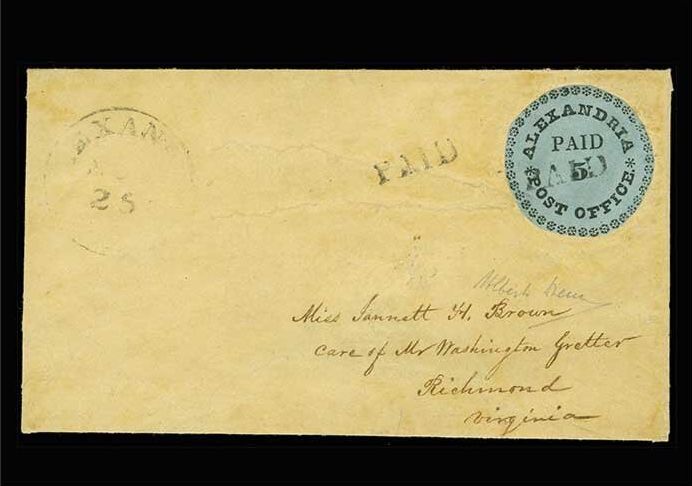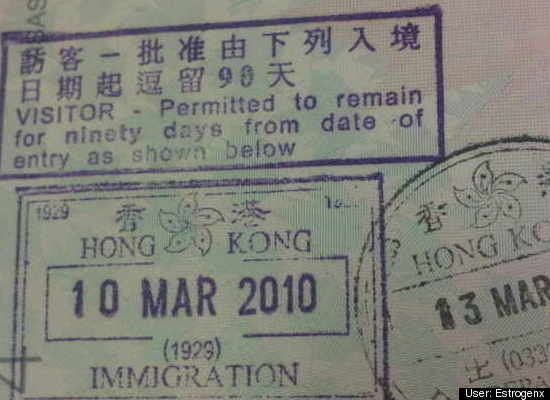On Nov. 24, 1847, a young man in Alexandria, Virginia, penned a letter to the woman of his dreams. Because their love was forbidden at the time (he was Presbyterian; she was Episcopalian), he wrote a note at the bottom asking her to burn the letter after reading it.
This secret letter and the budding romance story it contained would have faded away into the annals of history, if it weren’t for two key factors.
First, she did not burn the letter.
And secondly, the stamp he affixed to the envelope was only in use during a brief, transitory period in America’s postal history ― which meant it would one day become a sought-after collectors’ item.
Now known as the Alexandria Blue Boy, this rare, historic stamp is set to be auctioned in New York City on Saturday, with bidding starting at $1 million.
This is the first time the stamp is appearing in a public auction since 1967. The Alexandria Blue Boy sold for $1 million in 1981, according to The Washington Post, and is expected to fetch more than that when it hits the auction block this weekend.

The United States federal government began standardizing postage rates across the country and issuing prepaid postage stamps in the 1840s. During that time of transition, postmasters in some American cities issued stamps of their own. Now called “postmasters’ provisionals,” these stamps are prized among stamp collectors, or philatelists.
Postmaster Daniel Bryan, who lived in Alexandria, Virginia, issued provisional stamps during this period. The Alexandria stamps consist of a circle of rosettes containing the words “Alexandria Post Office.” The Blue Boy stamp is even rarer because it was printed on blue paper, while the other six surviving versions of the stamp were printed on buff-colored paper.
The tale of how this particular stamp survived has added to its mystique over the years. The story was uncovered in 2006 by the philatelist May Day Taylor, who spent hours digging through public records to track down the couple’s descendants.
The letter inside the envelope was reportedly written by then 24-year-old James Wallace Hooff to his 23-year-old second cousin, Jannett Hooff Brown. They lived a few blocks away from each other in Alexandria, but the letter was sent while Brown was visiting relatives in Richmond.
The letter doesn’t contain grand declarations of love. Instead, Hooff appeared preoccupied with figuring out which members of their family knew about the romance and how to continue keeping it secret.
“The reasons you give for not writing often, are good, for your cousin Wash. will be certain to say something, if you give him all your letters, to put in the office,” Hooff wrote, according to the Post. “But whenever you think you can write me a line without exciting the attention of your coz. Wash, do so, for it gives me a great deal of pleasure to receive a letter from you, even if it is only a short one.”
The letter is signed, “Yours with the greatest affection, W.” And at the bottom, Hooff wrote, “Burn as Usual” ― suggesting there were many more letters traveling between the couple.

The idea of relatives disapproving of a marriage between Episcopalians and Presbyterians may seem strange to Americans today. These two mainline Protestant groups have been working toward ecumenical unity for years. Episcopalians can now take Holy Communion at a Presbyterian Church (USA) congregation, and vice versa ― a significant sign of how close the relationship between these two denominations has grown.
But back in 1847, the dividing lines were much starker, according to James Hudnut-Beumler, a professor of American religious history at Vanderbilt University.
“In 1847 Presbyterians were staunch Calvinists, believing in predestination or God’s election of his chosen only to eternal life, and others to eternal damnation,” Hudnut-Beumler told HuffPost in an email. “This included the controversial doctrine of the damnation of unbaptized infants. Episcopalians rejected each of these beliefs and people took their religion very seriously in antebellum America.”
Hudnut-Beumler said there may have also been social class differences between Presbyterians and Episcopalians at the time that could have influenced parents’ feelings about the couple’s relationship.
Despite the opposition the couple faced while courting, their love story ultimately did have a happy ending. Hooff and Brown eventually got married in 1853, and had three children.
Their oldest daughter found the letter in a sewing box in 1907. The family kept the letter, but sold the envelope with the Blue Boy stamp to a collector for $3,000, which would be close to $82,000 today, according to Wayne Youngblood, editor of the American Stamp Dealer & Collector magazine.
Youngblood said news of the sale went “viral for its day,” and gave the stamp an immediate place in American philatelic history. He said the stamp is now one of the “unique touchstones” of American philately ― both because of its rarity and because of this love story.
“There are many rare or unique stamps, but those with a good story tend to capture the imagination of collectors and, sometimes, even non-collectors,” Youngblood told HuffPost.
Youngblood said there appears to be “a lot of interest worldwide” in this weekend’s sale.
“Since the stamp has not been sold publicly for more than 50 years ... it will be interesting to see the final hammer price,” he said.
The Alexandria Blue Boy stamp is being sold in New York City on Saturday evening by the philatelic auction house H.R. Harmer.

